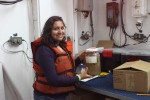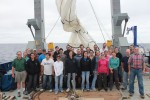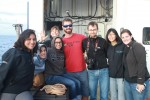“I am a science teacher, and I am terrified of the Ocean.” That was the first line in my application for the Teacher at Sea program that began my adventure in the Pacific Ocean this past summer. I found out about this National Science Foundation sponsored program for teachers when I attended a workshop at the Birch Aquarium at Scripps Institution of Oceanography (SIO) at the University of California, San Diego, in La Jolla.
The Teacher at Sea program provides an opportunity for educators to spend 30 days on a research vessel and participate in real-world, interdisciplinary research to promote greater awareness toward understanding and protecting the world’s oceans and its resources.
When I received the news that I had been chosen to be a “Teacher at Sea”, I felt incredibly lucky and horrified at the same time. I had nightmares of a giant octopus lifting the ship out of the water, as well as massive waves wiping everyone out on deck. Fortunately for me, none of that happened. Instead I got to work with and learn from a group of incredibly knowledgeable people whose determination inspired me on a personal and professional level.
For one month, I was part of a team of 37 oceanographers and 23 crewmembers on board the R/V Melville. This team of researchers from the California Current Ecosystem (CCE) Long Term Ecological Research (LTER) was led by CCE director Mark Ohman, and cruise chief scientist Mike Landry, both from SIO. Their research focus was on the effects of rising temperatures on one of the most productive ecosystems in the world, along the California coast.
As a Teacher at Sea, my duties were to assist with the deployment and recovery of nets, as well as to maintain a bilingual blog about my experiences. I offered to write my blog in Spanish for the largely Spanish speaking audience in the Imperial Valley, and the city of Calexico where I have worked as a science teacher for over a decade.
I was so excited to begin writing the blog and to get to know everyone, but during those first three days, the motion of the waves was very rough on me. My body kept trying to stay balanced while walking through the hallways of the vessel. Instead I would bump into the walls while trying to hold on to the nearest chair or table to keep from falling. In the bathroom, I felt so thankful for all the bars that surrounded the walls, especially when I took a shower!
Rubber mats were available everywhere to help keep our laptops in place. We would even place them under our dinner plates. It was common to see our drinks slide side to side across the dining tables. We were all very good at catching them before they fell. Velcro, bungee cords and rope were used to keep other things in place. I remember the Erlenmeyer flask that Brandon Stephens, a PhD student, had tightly wrapped with bungee cords on his table.
Before I knew it, my body had adjusted. I was no longer fighting the sensation of being on a waterbed when I tried to go to sleep. I even found it soothing. After being on the vessel for a few days, my fear of the ocean was gone. Its size was humbling, its motion mysterious, and I had no other way to feel but be part of it. I was ready to embrace the experience and I did.
I carried with me a Canon digital SLR camera, a GoPro camera strapped around my chest, and a small notebook. Because I was prepared with my equipment, I was fortunate enough to capture some incredible images of sea life. One amazing sight was the day graduate student Kyra Rashid and I spotted a giant sunfish. I screamed when I saw it from deck while my left hand took over photographing. At that moment I realized that my camera had become an extension of myself. On another occasion, Dr. Ohman and I used the GoPro camera attached to a 15 ft. pole to film remarkable gelatinous zooplankton called salps as they drifted by underwater.
For those 30 days, I was surrounded by the most determined and adaptable individuals I have ever met. Research was taking place 24 hours a day, and some scientists slept only 3 to 4 hours at a time. Every minute was very valuable, so I volunteered to help as much as I could, and asked many questions to understand the methodology of the experiments and the questions behind the research that was taking place.
The team of scientists was not only multi-disciplinary, but also multi-national, coming from countries as far away as France, Spain, Columbia, Germany and Denmark. Plankton ecologists, geochemists, physical and biological oceanographers, microbial diversity experts and seabird/marine mammal observers as well as computer program engineers worked in unison to solve problems. The expertise and knowledge on our ship was impressive, and I learned new things everyday.
Seeing how scientists work and solve problems in the field was the most valuable lesson for me. I understood the importance of the interrelation of scientific silence and discussion. The silence allowed the translation of deep thought about a specific problem, and the discussion collected many people’s ideas, allowing them to solve problems together.
This kind of interaction gave me a new perspective on what STEM (Science Technology Engineering and Math) really means in the classroom. It was clear to me that students need to model what scientists do. It takes time to come up with good ideas, and it is imperative to work together to create solutions. Students must be exposed to real life scenarios, and be taught how to interpret data. Similarly, students need to learn the importance of long-term research and how we use it to make models that could help us prepare for changes in our environment. Often, the science we teach students in class and in school laboratories involve procedures that end in quick answers. But in reality, science is a process, and it may take months and even years to collect and analyze data to arrive at conclusions.
The content knowledge that I have gained is invaluable. In many ways it surpasses the experiences I had at university, for I was taught by experts immersed in their professional environment, and that gave great meaning to the journey. Out at sea, I observed a universe of life in a single drop of ocean water. I came away determined to continue to teach about the ocean, its diversity, and the impacts that humans have in this marvelous world and resource.
Teachers everywhere are free to use the bilingual blog that I created (cce.lternet.edu/blogs/2014) for science content for Biology, Earth Science, and Environmental Science. Other content areas such as English and Spanish may utilize the blogs for literacy purposes. Furthermore, all past participants of the Teacher at Sea program, including me, have developed useful science lessons and videos that are available for free through the CCE website.

 Enlarge this image
Enlarge this image

